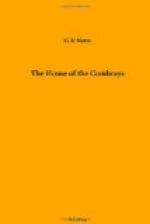long in noticing the mysterious behaviour of the occupants.
There were conferences conducted in whispers, visitors
who arrived at night and left at dawn, secret comings
and goings, in short, all the strange doings of a houseful
of conspirators, so that the good cure one day took
Lanoe aside and recommended him to be prudent, “predicting
that he would get himself into serious difficulties
if he did not quit the service of the Marquise as
soon as possible.”
Mme. de Combray,
in her exasperation, called the Abbe “Concordataire,”
an epithet which, from her, was equivalent to renegade.
She had the imprudence to add that the reign of the
“usurper would not last forever, and that the
princes would soon return at the head of an English
army and restore everything.” In her wrath
she left the parsonage, making a great commotion,
and went to beg shelter from her farmer Hebert, who
lived in a cottage used as a public house, called
La Bijude, where the road from Harcourt met that from
Cesny. Acquet was triumphant. The astonished
Abbe remained passive; and as ill luck would have
it, fell ill and died a few days afterwards. A
report was circulated, emanating from the chateau,
that he had died of grief caused by
Mme. de Combray.
Then people began to talk in whispers about a certain
basket of white wine with which she had presented the
poor priest. A week later all those who sided
with Acquet were convinced that the Marquise had poisoned
the Abbe Clerisse, “after having been imprudent
enough to take him into her confidence.”
Feeling ran high in the village. Acquet affected
consternation. The authorities, no doubt informed
by him, began making investigations when a nephew of
the Marquise, M. de Saint Leonard, Mayor of Falaise,
who was on very good terms with the Court, came down
to hush up the affair and impose silence on the mischief-makers.
This first bout between Acquet de Ferolles and the
family de Combray resulted in d’Ache’s
being forbidden the house of his old friend.
Feeling herself in the clutches of an enemy who was
always on the watch, she did not dare to expose to
denunciation a man on whose head the fate of the monarchy
rested. D’Ache did not come to La Bijude
the whole winter. Mme. de Combray lived
there alone with her son Bonnoeil and the farmer Hebert.
She had the house done up and repainted, but it distressed
her to be so meanly lodged, and she regretted the lofty
halls and the quiet of Tournebut. At the beginning
of Lent, 1806, she sent Lanoe for the last time to
Mandeville to arrange with d’Ache some means
of correspondence, and with Bonnoeil she again started
for Gaillon, determined never again to set foot on
her estates in Lower Normandy as long as her son-in-law
reigned there, and thoroughly convinced that the fast
approaching return of the King would avenge all the
humiliations she had lately endured. She had,
moreover, quarrelled with her daughter, who had only
come to Donnay twice during her mother’s stay,
and had there displayed only a very moderate appreciation
of d’Ache’s plans, and had seemed entirely
uninterested in the annoyance caused to the Marquise,
and her exodus to La Bijude.




